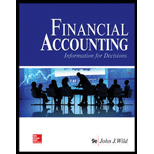
Concept explainers
a.
Introduction:
Inventory is a record of finished goods of a company which the can sell to the customer, work in progress which can be transform into finish good and raw material which is a means of production. Inventory is also classified as current asset in the
To calculate: Cost of goods sold and cost assigned to ending inventory using specific identification methods for L Company.
a.
Answer to Problem 14E
Cost assigned to ending inventory using specific identification method is $410 and cost of goods sold is $3,445.
Explanation of Solution
- Cost assigned to total inventory using specific identification method:
Using specific identification method closing inventory of 150 units will consist
| Particular | Units | Per unit ($) | Amount ($) |
| 7th May | 50 | 2.90 | 145 |
| 28th July | 50 | 2.80 | 140 |
| 3rd October | 50 | 2.50 | 125 |
| Total | 150 | 410 |
Cost of goods sold:
Thus, ending inventory using specific identification method is $410 and cost of goods sold is $3,445.
b.
Introduction:
Inventory is a record of finished goods of a company which the can sell to the customer, work in progress which can be transform into finish good and raw material which is a means of production. Inventory is also classified as current asset in the balance sheet and it is valued by FIFO, LIFO, specific identification and weighted average method.
To compute: Cost of goods sold and cost assigned to ending inventory using weighted average method for L Company.
b.
Answer to Problem 14E
Cost assigned to ending inventory using weighted average method is $385.5 and cost of goods sold is $3,469.50.
Explanation of Solution
Calculating the assigned amount of ending inventory according to weighted average method:
Weighted average cost is calculated as:
Thus, cost assigned to ending inventory using weighted average method is $385.5 and cost of goods sold is $3,469.50.
c.
Introduction:
Inventory is a record of finished goods of a company which the can sell to the customer, work in progress which can be transform into finish good and raw material which is a means of production. Inventory is also classified as current asset in the balance sheet and it is valued by FIFO, LIFO, specific identification and weighted average method.
To compute: Cost of goods sold and cost assigned to ending inventory using FIFO methods for L Company.
c.
Answer to Problem 14E
Cost assigned to ending inventory using FIFO method is $435 and of cost of goods sold is $3420
Explanation of Solution
- Cost assigned to ending inventory for the company L using FIFO :
Using FIFO method closing inventory of 150 units will consist:
Cost of goods sold:
| Particular | Units | Per unit ($) | Amount ($) |
| 1st Jan | 96 | 2 | 192 |
| 7th May | 220 | 2.25 | 495 |
| 28th July | 544 | 2.5 | 1360 |
| 3rd Oct | 480 | 2.8 | 1344 |
| 19th Dec | 10 | 2.9 | 29 |
| Total | 3420 |
Thus, cost assigned to ending inventory using FIFO method is $435 and of cost of goods sold is $3420.
d.
Introduction:
Inventory is a record of finished goods of a company which the can sell to the customer, work in progress which can be transform into finish good and raw material which is a means of production. Inventory is also classified as current asset in the balance sheet and it is valued by FIFO LIFO, specific identification and weighted average method.
To compute: Cost of goods sold and cost assigned to ending inventory using LIFO methods for L Company.
d.
Answer to Problem 14E
Cost assigned to ending inventory using LIFO method is $313.50 and of cost of goods sold is $3541.5 and FIFO method of assigning cost to inventory will yield highest net income as cost of goods cold is lowest in it.
Explanation of Solution
- Calculating the assigned amount of ending inventory according to LIFO method:
| Particular | Units | Per unit ($) | Amount ($) |
| 1st Jan | 96 | 2 | 192 |
| 7th may | 54 | 2.25 | 121.50 |
| Total | 313.50 |
Cost of goods sold:
| Particular | Units | Per unit ($) | Amount ($) |
| 7th May | 166 | 2.25 | 373.5 |
| 28th July | 544 | 2.5 | 1360 |
| 3rd Oct | 480 | 2.8 | 1344 |
| 19th Dec | 160 | 2.9 | 464 |
| Total | 3541.5 |
Thus, cost assigned to ending inventory using LIFO method is $313.50 and cost of goods sold is $3541.5.
FIFO method of assigning cost to inventory will yield highest Net income as cost of goods cold is lowest in it.
Want to see more full solutions like this?
Chapter 5 Solutions
Loose Leaf for Financial Accounting: Information for Decisions
- Principles of Accounting Volume 1AccountingISBN:9781947172685Author:OpenStaxPublisher:OpenStax College
 Individual Income TaxesAccountingISBN:9780357109731Author:HoffmanPublisher:CENGAGE LEARNING - CONSIGNMENT
Individual Income TaxesAccountingISBN:9780357109731Author:HoffmanPublisher:CENGAGE LEARNING - CONSIGNMENT  College Accounting, Chapters 1-27AccountingISBN:9781337794756Author:HEINTZ, James A.Publisher:Cengage Learning,
College Accounting, Chapters 1-27AccountingISBN:9781337794756Author:HEINTZ, James A.Publisher:Cengage Learning, Financial And Managerial AccountingAccountingISBN:9781337902663Author:WARREN, Carl S.Publisher:Cengage Learning,
Financial And Managerial AccountingAccountingISBN:9781337902663Author:WARREN, Carl S.Publisher:Cengage Learning, Financial AccountingAccountingISBN:9781337272124Author:Carl Warren, James M. Reeve, Jonathan DuchacPublisher:Cengage Learning
Financial AccountingAccountingISBN:9781337272124Author:Carl Warren, James M. Reeve, Jonathan DuchacPublisher:Cengage Learning





